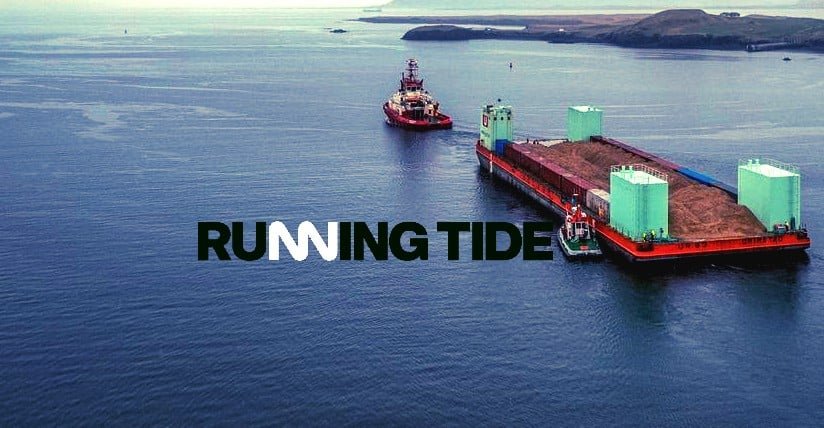Ocean carbon removal startup Running Tide has delivered its first-ever carbon removal credits pre-sold to e-commerce giant Shopify.
US-based Running Tide is a carbon dioxide removal (CDR) company that sinks wood in the Atlantic Ocean to sequester carbon. Shopify is one of the first buyers of the carbon removal credits generated by the startup’s ocean carbon sequestration.
Shopify and Running Tide CDR Credits Deal
Running Tide has been exploring an ocean sequestration process involving growing and sinking algae. But for Shopify’s open ocean carbon removal project, only terrestrial wood was sunk.
The startup has five funding rounds from other major investors, which include Wells Fargo Innovation Incubator and Yes VC. Microsoft, Stripe, and the Chan Zuckerberg Initiative have also agreed to pre-purchase carbon removal credits from the startup.
Under their deal, Shopify receives 100 of the 275 net tons of carbon removal credits created by Running Tide’s project. The climate startup had sunk 1,000 tons of limestone-coated wood waste to the ocean floor about 100 miles off the coast of Iceland.
The wood residues, which would have been burned and emit carbon, were from forest trimming operations in Canada and Europe. So, instead of letting them release CO2, Running Tide prevents the emissions by storing the wood in the ocean for thousands of years.

The carbon removal startup has been working with Shopify since 2020 via the latter’s Sustainability Fund. It’s an initiative founded by the e-commerce giant to provide financial support for carbon removal projects.
The 275 tons of removal are very insignificant when compared to global emissions that need to be removed. It’s also a small fraction of corporate buying of carbon removal where large companies are purchasing million tons of CO2.
Still, their project is the first-of-its-kind in the carbon sequestration space that has been tested and audited.
Running Tide’s Unique Approach to CDR
Running Tide processes carbon-rich forestry residues into carbon buoys, or drifters on which to grow macroalgae. They then coat the carbon buoys with calcium carbonate that stimulates a process known as enhanced alkalinity, a recognized CDR approach to sequestering carbon.
The limestone coating helps avoid ocean acidification, the startup said.
This unique approach moves the CO2 from the fast carbon cycle (in the atmosphere and biosphere) to the slow carbon cycle (deep into the ocean floor). Geologic processes in the slow carbon cycle facilitate storage of the CO2 for thousands of years.
Running Tide has designed a system that amplifies natural ocean based CDR. They then deploy their system far from coasts and focus on three key pathways that remove carbon:
- Sinking of terrestrial biomass (wood buoys),
- Dissolution of CO2 in surface waters (calcium carbonate), and
- Photosynthetic fixation and sinking of marine biomass (macroalgae).
The core principle of Running Tide’s system is the creation of simple and modular components like carbon buoys that can be placed in ocean currents. They remain buoyant for a certain amount of time, disperse in the currents, and then go down to the seafloor.

As the carbon buoys drift, they either alkalinize the ocean via mineral dissolution or remove carbon by growing macroalgae. When sunk, the buoys bring both terrestrial and marine biomass to the ocean floor.
The company said that the formula they use in calculating the amount of sequestered carbon reflects the weight of the sunk wood and the amount of limestone dissolved. They determine that through cameras.
Asserting the credibility of their approach to CDR, Running Tide’s CEO CEO Marty Odlin noted that:
“From the best available science, which is what we operate on, we have achieved a high degree of permanence and low risk of reversal [for the carbon].”
Running Tide leverages the expertise of independent, 3rd-party ocean and climate scientists with in-house engineers to design their CDR system. Odlin said their project adhered to the Scientific Advisory Board standards and was reviewed by an independent science review board.
Deloitte, a leading audit services provider, is the official verifier for their Shopify deal.
What Are The Gaps to Fill-in?
Running Tide has developed measurement, reporting, and verification (MRV) technologies to monitor the location, timing, and progress of CDR deployments.
Though there is a 3rd-party auditor, there’s no normal avenues for verification yet as there are no similar projects to compare with. So the companies determine the number of ocean carbon removal credits by using a methodology they both developed.
They will share their framework to other ocean CDR companies considering a similar process, they said.
However, Running Tide doesn’t monitor the exact ecosystems where it’s sinking the carbon buoys at this time. That’s because their current work is still small-scale, which makes it hard to measure their exact impact at the moment.
This is why others think that the startup needs to have verification in place to bring more confidence into their CDR system. This will also help inform others working on CDR solutions and ensure the approach is safe for the ocean. Shopify seconded saying that it’s “a big-time learning opportunity” for scientific experts to get their eyes on.
The e-commerce didn’t exactly say how much they paid Running Tide for the CDR credits. But the latter said that they’re charging between $250 and $350 per tonne of carbon removal credits.
In March, Microsoft paid Running Time to remove 12,000 tons of CO2 over the next two years. But they also didn’t disclose the amount of their payment.
The innovative approach of Running Tide for ocean carbon removal holds promise in curbing carbon emissions. Their carbon credit deal with Shopify and other supporters of CDR highlights the potential of collaborations to address climate change.

